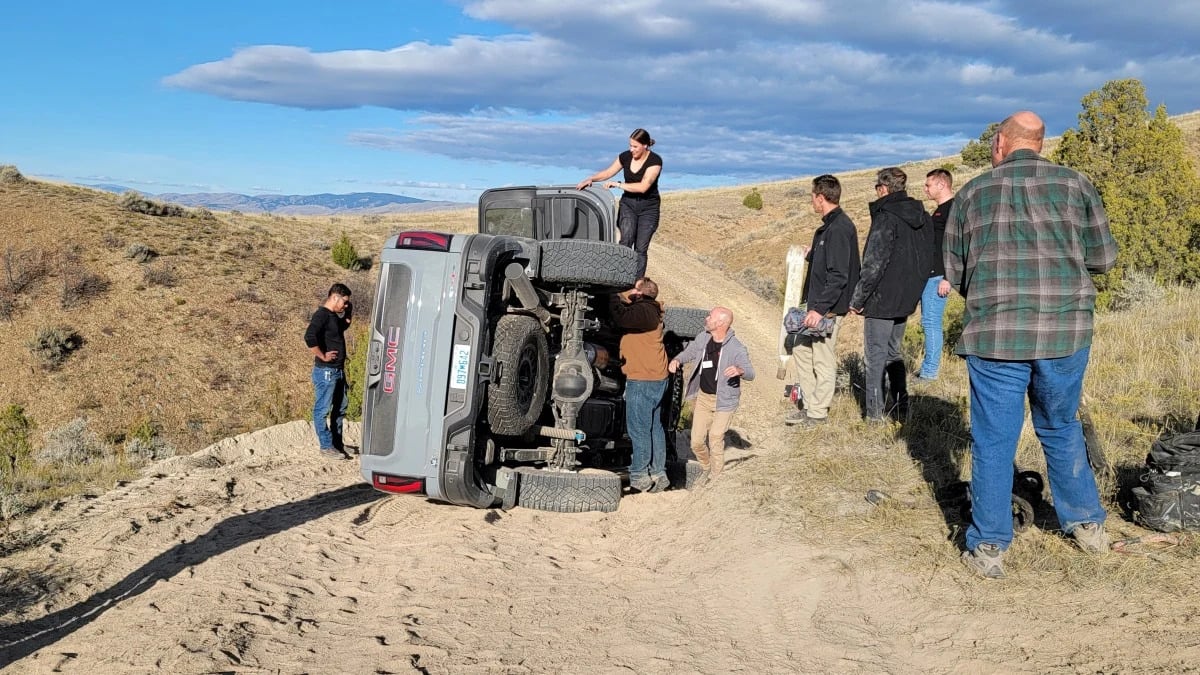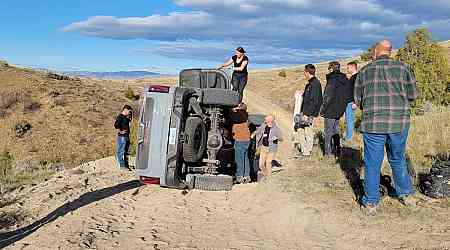It was a mild spin followed by an off. No contact — not even a position battle. I’d merely overcooked a corner, tried to get my Miata turned before I ran out of track, and failed. I went straight off (albeit backwards) and found myself looking back at Summit Point’s turn five, watching the other drivers in my session zing in from house left at a yellow-flag pace. Upon receiving the go-ahead from the corner worker, I goosed the little roadster’s throttle just enough to coax it out of the soft grass, completed my lap, and reported back to my instructor. When I proudly informed him that my incident had gone as well as could be expected, he nodded with what I thought was approval before not-so-gently reminding me that no matter how gracefully handled, screwing up is still screwing up. Not his exact words, but apparently we’re still maintaining some level of decorum around here.
What did I learn from that? Well, for starters, given how trashed Summit Point’s track surface once was, trail braking into turn five required more finesse. But more to the point, I learned a lot about how I behave once things go completely wrong. It was neither my first off-pavement excursion nor my last, but the first I’d experienced at high speed on a track. In many ways, it was even less noteworthy than some of my previous antics.

2001: Riding in the back seat of my buddy’s Isuzu Trooper. He hesitated when a trash can rolled into the road but kept his eyes on it too long. I saw the stopping distance to a conversion van ahead disappearing but didn’t open my mouth fast enough to warn him. He looked up but too late. We ate the back of the van at 30 miles per hour. Clean hit. Bruised ribs. Scratch one Trooper.
2003: Driving my parents’ 2001 TJ Wrangler in the mountains. I pulled out of a friend’s driveway and proceeded to make it all of half a mile before understeering through an accumulation of wet mush left over from the autumn leaves. I put the Wrangler into a rock wall about 6 feet off the side of the road. Only cost me a fender and some dignity.
2008: Riding shotgun with the same wiseass instructor, this time at Virginia International Raceway. His PTD Neon race car shat out a wheel bearing and spit us onto the grass. His distress over putting me in harm’s way was obvious, but I wasn’t upset. I knew what I had signed up for. That impressed him and he said as much. And he was the one I called when, in 2016, I blew a cold Pirelli coming out of Big Bend at Shenandoah and put my driver’s side rear fender into a concrete wall.

But let’s stick with 2008 for a moment, because that was when I started writing about cars. I wouldn’t get my first professional gig until 2014, but broadly speaking, I’ve been doing this for the better part of 16 years. For the first 15 of those, I kept my nose completely clean. Sure, doors get dinged and tires get worn, and I’ve handed off loaners with muddy floor mats more times than I can count, but not once have I returned a press vehicle meaningfully worse for wear.
Believe it or not, that is remarkable. If you’re deep into this business, the odds are not on your side. Even the best professionals run into things; it’s the nature of pushing the envelope. Those who don’t make their own mistakes — or are simply fortunate enough that their errors result in no meaningful consequences — remain at the mercy of their surroundings, their peers and in some cases, their competitors. There are no guarantees in this world, but chances are, at some point, you’re going to experience what I did on that hot, sticky afternoon at the track: the distinct feeling of passing the point of no return.
And so, when I found myself dangling from my seat belt several feet above my co-driver in a 2024 GMC Sierra HD AT4X last year, the first thing that popped into my head was neither a stream of epithets nor the cold embrace of panic. Instead, it was, “I should really shut that motor off.”
Let’s back up.

GMC had invited me/Autoblog to Montana to drive not one, but three new trucks: the 2024 Canyon AT4X, the AEV variant of the same and of course, the Sierra HD AT4X. My review of the Canyon AT4X and its AEV counterpart made it to “print,” but for reasons that are hopefully becoming clear, my Sierra write-up did not.
Off-road trucks mean off-road stuff. Each of our stints so far had put the caravan of GMC-driving journalists off pavement to some degree or another. This was to be our last leg of the day. My drive partner and I had swapped the smaller Canyon for the Sierra and set off on a trail conveniently (deliberately) carved into the hills on the same property where we’d conclude our program later that evening.
Our attention began falling into the gravity well of quitting time; we’d been at it for nearly 10 hours at that point, maintaining a brisk cadence with multiple trucks to evaluate. The light was getting long, low and blinding. Before dusk in Montana, you must first contend with dust. My hand was casually resting on the A pillar handle, as much to block the glare as anything else.
From the driver’s perspective, the berm was likely invisible behind the pale cloud of dust kicked up by the caravan in front of us. We were the final truck in the queue. With the sun setting to our rear, there was no telling one phase of dirt from another. The first sign of trouble came not from my eyes, but my ears.
Technical driving has more in common with Can-Can than commuting. Whether you’re carving apexes or climbing a rock face, getting it right comes down to managing the weight of your automobile. Your sense of balance — as it relates to your fundamental spatial awareness — is secondary only to your vision when you’re fully committed.

And the driver was, in fact, committed. Unfortunately, too far to the right, inside of our line and setting us up to cut the corner. No big deal, right? It’s an off-road truck. But the trail falls away as it rounds this bend, and by not mere inches, but feet. We couldn’t see the extent of his mistake in the blinding glare. As we crested it, the driver’s side wheel reached for purchase. And reached. And reached.
Years of going beyond the point of no return has attuned my inner ear to three settings: “everything’s cool,” “maybe grab a handle” and “oh, this is happening.” Suddenly, my biological accelerometer told me that we were about to blast straight from “cool” to “this is happening” without time for a pit stop in “handle.” From there on out, my memory is quite vivid.
Everything became automatic. My right hand tightened its hold on the A pillar handle while my left thigh practically lunged for the center console. Brace in the cage, something way back there told me. I flinched to the left automatically. Why? The airbag, it said again. Before that thought had faded, sure enough, I heard the “pop.”
But that wasn’t my airbag, it was the driver’s. It went off just as the truck teetered past its equilibrium point on the driver’s side. At that point, three things occurred to me in quick succession: First, we’re on a narrow, single-lane trail on the side of a hill. Second, that hill gives way to a 30- or 40-foot drop somewhere off to the driver’s side. And third, this is a big, heavy truck …
But before I could finish those calculations, my inner alarm bell stopped ringing. Half a second later, the truck settled. I looked to my left — down, if you’re a stickler for absolutes — and saw the driver, surprised but unharmed. I peeked over my left shoulder and found our rear-bench occupant — a GM engineer along to answer questions — likewise disheveled but uninjured. Amidst a quick round of “You OK?” and some dazed affirmatives, I instinctively reached down and hit the ignition switch to kill the big Duramax.


It took me two tries to reassure the OnStar operator that we had the situation under control. And by that point, it was even true. GMC’s support staff surrounded us within seconds of the rollover. Just as I hung up with OnStar, the door behind me opened. In hopped our support EMT (seriously, I’ve never seen somebody more excited for the opportunity to do their job), who asked everybody to honestly evaluate their physical condition before we pivoted to an extraction plan.
At that point, she told us we could go out through the doors, windows or the windshield. Dealer’s choice, so to speak. Mind you, apart from the singular open rear door, those things were still very much closed, blocked and/or intact. Somebody clearly brought her toys.
We all opted to take the already-open rear door. This put me last in line for extraction, since I’d have to fall into the driver’s seat (more accurately, the dirt where the window used to be) in order to re-orient myself so that I could wiggle into the rear compartment. I waited patiently in my DOT-approved hammock while the rear passenger and driver made their way out. With them clear, I freed myself of the belt and used the steering wheel and driver’s seat to get myself upright, stepping then onto the sturdy leg of the still-beaming EMT. In her version of this, I was probably on fire or something.
Once clear, I got my first good look at just how hinky things had gotten. The Sierra rested peacefully on its side in soft sand a few feet from the edge of the trail. We were so far off our ideal line that our mistake ended up being less costly than it could have. Another foot or two to the left, or a little more steering lock to the right, and our inertia could have taken us clear off the side of the hill.
While GM’s on-site crew went to work righting the truck and dragging it off behind a curtain, I conducted my own internal debriefing. From the point of no return until the dust both physically and metaphorically settled, the entire situation had been outside of my control. Nevertheless, I had emerged from the chaos already working the problem.

The wellness checks? The conversation with OnStar? Shutting off the engine? Automatic, every bit of it. Why? Call it what you will — Experience. Practice. Old-fashioned repetition. Sure, we had support close at hand. I could have sat there in stunned silence awaiting extraction and nobody would have begrudged me the time and space necessary to process things. Auto journos aren’t expected to think for themselves under the best of circumstances, let alone in any sort of crisis.
And something as simple as thinking to kill the ignition can be the difference between a small screw up and a really, really big one. While the Duramax continued to idle dutifully despite its orientation, those diesels do not like being on their sides. Engine oil is a lot like diesel fuel, and while the oiling system utilizes hydraulic pressure to keep lubricant flowing, it relies in part on gravity to keep everything where it’s supposed to be. On its side, the engine can ingest oil into the cylinders, which can lead to diesel runaway — a potentially catastrophic feedback loop.
In exchange for the opportunity to tag along with the recovery crew, I agreed to keep some particulars of the accident follow-up to myself. I can, however, say this: After being righted, the Duramax's dipstick was bone dry, meaning at minimum, it had ingested more than a quart of 15W-40. Despite its surprisingly minor exterior blemishes (see that last pic above), that Sierra did not leave the premises under its own power. It may never have been fired up again, in fact. Many evaluation trucks are technically pre-production and thus destined for the crusher anyway; this one simply had a shorter journey than most, though I wouldn't be shocked if curious engineers stripped it for both parts and data after the incident.
But far more importantly, thanks to quick thinking by all parties, that was the extent of the harm done. Most of what we learn from failure, we internalize with the goal of preventing the next one. That’s prudent and even noble. But sometimes, the recovery itself can be the lesson.
Whatever you do, if you’ve been doing it long enough, you develop a sense for when things have gone completely and irrevocably wrong. Maybe you lost control. Maybe you never had it to begin with. But whether you find yourself 2 feet too deep into a braking zone or simply on the receiving end of a calendar invitation marked “Business Update,” remember: life keeps happening past the point of no return.





























